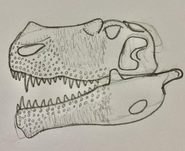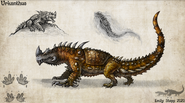Urkanthus is a large lizard-like fanged wyvern known for its stench inflicting breath attacks.
| Urkanthus | |
|---|---|
| ★★★★☆☆☆☆ | |

| |
| Names | |
| Titles | Murk Spike Wyvern |
| Nicknames | Beiunsai |
| General Info | |
| Monster Class | Fanged Wyvern |
| Habitats | Primeval Coastline, Flooded Forest, Old Jungle, Jungle, Old Swamp, Marshland, Primal Forest, Ruined Pinnacle, and Great Forest |
| Size | |
| Relatives | Adamantine Urkanthus |
| Signature Move | Stench Mist |
| Elements | None |
| Ailments | |
| Weaknesses | |
| Creator | Nrex117 |
Description[]
Urkanthus is a monster that greatly resembles a cross between an armadillo and a thorny lizard. Urkanthus has orange and black scales and osteoderms covering its hide as well as many large spikes and armor plating while the underbelly of this monster possesses small scutes that are white and black in color. Urkanthus possesses a highly developed skull that is covered almost entirely in hardened skin and possesses small fanglike spikes and jagged horns sitting at the back of its skull. The limbs of this quadrupedal wyvern are powerfully built and are adorned with various armored scales and scutes. The tail of Urkanthus is robust and is covered in spiny armor plating that extends the entire length of the tail.
Abilities[]
Urkanthus is a physically powerful monster that is capable of delivering devastating blows that send hunters flying with its claws and tail, Urkanthus is capable of delivering powerful attacks with its jaws. Urkanthus is capable of firing out projectiles of foul-smelling mud, these projectiles will leave a small temporary cloud of stench at the area of impact that will cause those standing within it to become afflicted with the soiled status effect. Urkanthus can also use its powerful forelimbs and large claws to burrow and fling earth and dust towards its foes.
Ecological[]
Field Guide Entry[]
| Urkanthus | |
|---|---|
| Fearsome insectivorous fanged wyverns that are known for their foul smelling breath and thorny appearance. These lizard-like monsters primarily prey upon insects and other small animals. | |
Taxonomy[]
- Kingdom: Animalia
- Phylum: Chordata
- Class: Reptilia
- Clade: Dinosauria
- Order: Wyveropoda
- Family: Dinotherosauridae
- Subfamily: Retrosaurinae
- Genus: Coronasuchus
- Species: C. beiunsai
- Name Meaning: Crowned Bone Crushing Crocodile
- Common Name: Urkanthus
Rage and Tired States[]
- Rage: Urkanthus will roar loudly as it begins to emit steam from its nostrils and back, its eyes will go from a yellow color to a bright red.
- Tired: Urkanthus will begin to droll and will become susceptible to clutch claw-based attacks and actions.
Habitat Range[]
Urkanthus are found patrolling the waterways and shoreline of the Primeval Coastline. These semi-aquatic fanged wyverns can also be found inhabiting the Flooded Forest, Old Jungle, Jungle, Old Swamp, Marshland, Primal Forest, Ruined Pinnacle, and Great Forest
Ecological Niche[]
Despite their fearsome horns, claws and powerful jaws Urkanthus primarily prey upon large insects such as Hermitaur, Altaroth, Vespoid and Bnahabra but they will also prey upon any available available arachnids and crustaceans as well. Despite mainly preying upon prey much smaller than itself Urkanthus has very little in terms of predators with most monsters avoiding the heavily armored and foul-smelling monsters for easier prey. Urkanthus does need to be wary of indiscriminate carnivores like Deviljho as the hyper aggressive monsters' cares little for the foul-smelling stench and its powerful jaws and ravenous appetite could easily make work of the armored hide of an Urkanthus.
Biological Adaptations[]
Urkanthus are adapted for life within temperate forests and swampland environments and prefer areas with high concentrations of small fish to prey upon. The hide of Urkanthus is armored and shell-like and serves to protect it from the bites and stings of parasitic insect swarms and from any predators that attempt to prey upon it. The forelimbs of these lizard-like wyverns are robust and possess large claws that the fanged uses to stabalize itself in the fast-flowing streams it forages within. The skull of these fanged wyverns possesses moderately powerful jaws filled with crocodile-like teeth. Numerous small dorsal plates run down the back and neck of Urkanthus and aide wyvern in thermoregulation and display.
Behavior[]
Urkanthus is a large, nomadic, and territorial monsters, prone to wandering vast distances in search of prey. Its status on the food chain causes it to avoid larger threats and have given it an aggressive nature.
Tracks[]
Urkanthus is capable of leaving behind multiple tracks that hunters can use in tracking them. The tracks can be found along the ground as footprints and claw marks as well as gnawed bone fragments and monster carcasses.
Specific local interactions[]
Urkanthus is known to burrow into and swim within muddy water where it will attempt to ambush other monsters and hunters that happen to pass by.
Special behaviors[]
Urkanthus can occasionally be seen resting upon large rock formations. It can also be seen gnawing upon bone piles throughout the area as well as burying chunks of meat in secluded areas from the prey it has slain.
Interactions with other monsters[]
Urkanthus are highly territorial predators and are known to actively hunt and kill other predatory species that trespass on its territory whether they are large or small.
With Urkanthus[]
Although typically solitary creatures, adult Urkanthus are known to pair up when they mate for a short while. Adult females will typically make a nest and lay a clutch of eggs ranging from 20-60 in total. The mother will defend her nest mound and protect the young until they hatch. After the young hatch, they will fend for themselves and receive no care from their mother.
Turf Wars[]
Vs Bulldrome[]
Urkanthus wins.
Vs Jyuratodus[]
Urkanthus wins.
Vs Barroth[]
Barroth wins.
Combat Information[]
Breakable Parts[]
- The horns on the head of Urkanthus can be broken.
- The scutes on the back of Urkanthus can be broken.
- Urkanthus's forelimbs can be scarred.
- Urkanthus's tail can be severed.
Physical Damage Effectiveness[]
Elemental Damage Effectiveness[]
Ailment Effectiveness[]
| Status Effects | |||||||
|---|---|---|---|---|---|---|---|
| Effectiveness | ✖ | ★ | ★ | ★★ | ★★ | ★ | ★★ |
Item Effectiveness[]
| Item | ||||||
|---|---|---|---|---|---|---|
| Effectiveness | ★★ | ★★★ | ★★ | ★ | ★ | ★★ |
Carves[]
Low Rank
|
Icon |
Item Name | Description | Drop Rate |
|---|---|---|---|
| Urkanthus Scute | Common Urkanthus material. Mostly obtained through carving. These scales contain bones within them that give them their distinctive keeled shape and hardness. | Common | |
| Urkanthus Thorn | Common Urkanthus material. Mostly obtained as a reward. Thick boney spines cover the hide and shell of these fanged wyverns. | Common | |
| Urkanthus Claw | Common Urkanthus material. Mostly obtained through breaking its forelegs. Although not very sharp these claws are hard and curved allowing them to tear through terrain and the hides on monsters with ease. | Rare | |
| Urkanthus Fang | Common Urkanthus material. Mostly obtained through carving. Thick, pointed fangs that are sturdy enough to pierce the sturdiest hides and bones of monsters. | Rare | |
| Urkanthus Horn | Common Urkanthus material. Mostly obtained by breaking its head. The horns sitting atop the head of Urkanthus are used to aid it in burrowing. | Rare | |
| Urkanthus Tail | Common Urkanthus material. Mostly obtained through breaking its tail. A long a muscular tail carved from the body of an Urkanthus allows expert mobility in water. | Very Rare | |
| Geyser Gemstone | Common Urkanthus material. Mostly obtained through carving. A gemstone found within the boiler-like water sac of an Urkanthus. | Very Rare |
High Rank
| Icon | Item Name | Description | Drop Rate |
|---|---|---|---|
| Urkanthus Scute+ | Rare Urkanthus material. Mostly obtained through carving. These scales contain bones within them that give them their distinctive keeled shape and hardness. | Common | |
| Urkanthus Thorn+ | Rare Urkanthus material. Mostly obtained as a reward. Thick boney spines cover the hide and shell of these fanged wyverns. | Common | |
| Urkanthus Claw+ | Rare Urkanthus material. Mostly obtained through breaking its forelegs. Although not very sharp these claws are hard and curved allowing them to tear through terrain and the hides on monsters with ease. | Rare | |
| Urkanthus Fang+ | Rare Urkanthus material. Mostly obtained through carving. Thick, pointed fangs that are sturdy enough to pierce the sturdiest hides and bones of monsters. | Rare | |
| Urkanthus Horn+ | Rare Urkanthus material. Mostly obtained by breaking its head. The horns sitting atop the head of Urkanthus are used to aid it in burrowing. | Rare | |
| Urkanthus Tail+ | Rare Urkanthus material. Mostly obtained through breaking its tail. A long a muscular tail carved from the body of an Urkanthus allows expert mobility in water. | Very Rare | |
| Geyser Gemstone+ | Rare Urkanthus material. Mostly obtained through carving. A gemstone found within the boiler-like water sac of an Urkanthus. | Very Rare |
G/Master Rank
|
Icon |
Item Name | Description | Drop Rate |
|---|---|---|---|
| Urkanthus Shard | Very rare Urkanthus material. Mostly obtained through carving. These scales contain bones within them that give them their distinctive keeled shape and hardness. | Common | |
| Urkanthus Spirescale | Very rare Urkanthus material. Mostly obtained as a reward. Thick boney spines cover the hide and shell of these fanged wyverns. | Common | |
| Urkanthus Hardclaw | Very rare Urkanthus material. Mostly obtained through breaking its forelegs. Although not very sharp these claws are hard and curved allowing them to tear through terrain and the hides on monsters with ease. | Rare | |
| Urkanthus Doomfang | Very rare Urkanthus material. Mostly obtained through carving. Thick, pointed fangs that are sturdy enough to pierce the sturdiest hides and bones of monsters. | Rare | |
| Urkanthus Crownhorn | Very rare Urkanthus material. Mostly obtained by breaking its head. The horns sitting atop the head of Urkanthus are used to aid it in burrowing. | Rare | |
| Urkanthus Lash | Very rare Urkanthus material. Mostly obtained through breaking its tail. A long a muscular tail carved from the body of an Urkanthus allows expert mobility in water. | Very Rare | |
| Urkanthus Mantle | Very rare Urkanthus material. Mostly obtained through rare rewards. | Very Rare |
Shiny Item Drops[]
Material Items []
Urkanthus has a chance to drop Large Monster Tears with all of its breaks.
Slinger Ammo[]
When Urkanthus receives a high damage impact, it can drop Thorn Pods for the hunter's slinger.
Notes, Trivia & Credits[]
- The original name for this monster was Beiunsai, which is a combo of the Icelandic word for bone and the Japanese word for crushing. The name was created by Comet Y.
- The steam attacks used by Urkanthus deal both water and fire elemental damage but only inflicts severe waterblight.
- Urkanthus, just like real-world crocodilians, has an immensely powerful immune system that allows it to be very resistant to illness and poisons.




